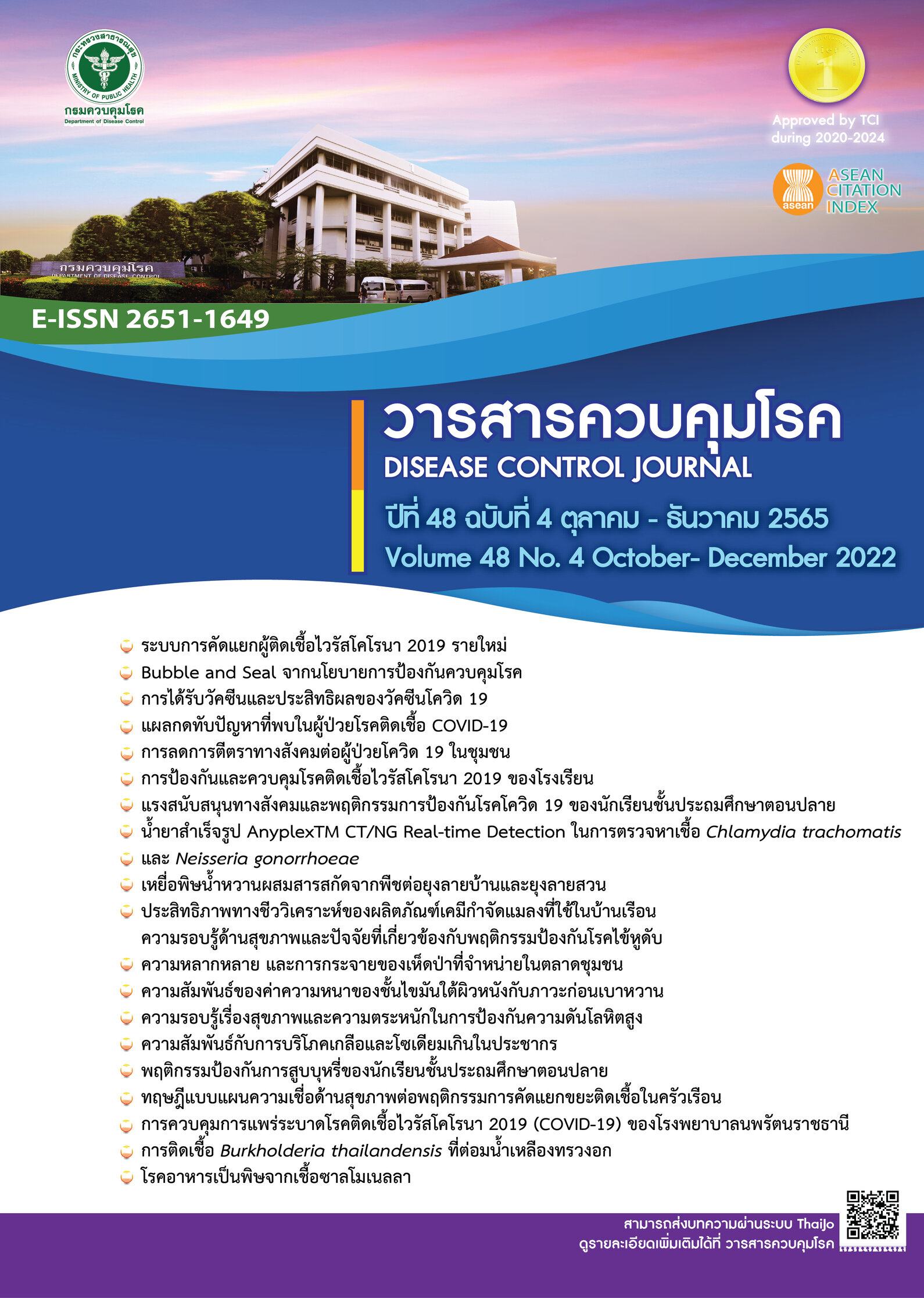The correlation of skinfold thickness and prediabetes status in patients treated in family medicine department, King Chulalongkorn Memorial Hospital
DOI:
https://doi.org/10.14456/dcj.2022.72Keywords:
prediabetes, skinfold thickness, hemoglobin A1C, impaired fasting glucose, non-diabetic, diabetes mellitusAbstract
The purpose of this cross-sectional analytical research was to study the relationship between skinfold thickness and prediabetes status. Patients with prediabetes status, also known as Impaired Fasting Glucose (IFG), and patients without diabetes (non-diabetic) receiving treatment in the Family Medicine Department, King Chulalongkorn Memorial Hospital. A total of 1,056 patients were included in this study. The study was conducted between March and August 2021. Data were collected using questionnaires and health measurement tools. According to the findings, the thickness of subcutaneous fat layer at the triceps and sub-scapular regions was found to be statistically significantly associated with prediabetes status and fasting IFG in a positive manner (logistic regression coefficient = 0.040 (p=0.018) and 0.028 (p=0.024), respectively). That means when the thickness of subcutaneous fat layer at the triceps and subscapular locations grows, there will be an increased risk of developing prediabetes status (odds ratio 1.040 (95%CI 1.007-1.074) and 1.028 (95%CI 1.004-1.054), respectively). However, there was no significant difference in the likelihood of developing prediabetes condition based on the measurements of subcutaneous fat layer at the biceps and suprailiac region. As a result, it is recommended that screening for prediabetes condition be done by measuring the thickness of subcutaneous fat layer at the triceps and subscapular locations. The technique can be used to prevent prediabetes condition from the start as well as to supplement the existing diabetes screening test.
Downloads
References
International Diabetes Federation. IDF Diabetes Atlas. 7th ed. Brussels: International Diabetes Federation; 2015.
International Diabetes Federation. IDF Diabetes Atlas. 9th ed. Brussels: International Diabetes Federation; 2019.
Neelasri J, Tanaphuwanont O. Factors Associated with HbA1c Levels of Type 2 Diabetes Patients, Thayang Hospital, Phetchaburi Province, Thailand. Region 4-5 Medical Journal. 2020;39(4):715-28. (in Thai)
Department of Disease Control (TH), Bureau of Non-Communicable Diseases. 5-Year National NCD Prevention and Control Strategic Plan. (2017-2021);2017. (in Thai)
Ekplakorn W, Phakcharoen H, Sathiannoppakao W. Thai National Health Examination Survey 6th 2019-2020. Bangkok:Mahidol University; 2021. (in Thai)
The Royal College of Physicians of Thailand, The Diabetes Association of Thailand, The Endocrine Society of Thailand, Department of Medical Services, National Health Security Office. Clinical Practice Guideline for Diabetes 2017; 2017. (in Thai)
American Diabetes Association. Classification and Diagnosis of Diabetes. Diabetes Care 2017;40(1):S11-24.
Ruiz-Alejos A, Carrillo-Larco RM, Miranda JJ, Gilman RH, Smeeth L, Bernabé-Ortiz A. Skinfold thickness and the incidence of type 2 diabetes mellitus and hypertension: an analysis of the PERU MIGRANT Study. Public Health Nutr. 2020;23(1):63-71.
Casadei K, Kiel J. Anthropometric Measurement [Internet]. 2020 [cited 2020 Apr 28]. Available from: https://www.ncbi.nlm.nih.gov./books/NBK537315.
Hulley SB, Cummings SR, Browner WS, Grady D, Newman TB. Designing clinical research: an epidemiologic approach. 4th ed. Philadelphia: Lippincott Williams & Wilkins; 2013.
Negrete RJ, Hanney WJ, Pabian P, Kolber MJ. Upper body push and pull strength ratio in recreationally active adults. Int J Sports Phys Ther. 2013;8(2):138-44.
Devulapally Y, Negi DS, Pasula KB. Comparative study of anthropometric parameters in diabetic and non-diabetic human beings. National Journal of Physiology Pharmacy and Pharmacology. 2017;(10):1.
Bacchi E, Caverdon V, Zancanaro C, Moghetti P, Milanese C. Comparison between dual-energy X-ray absorptiometry and skinfold thickness in assessing body fat in overweigh/obese adult patients with type-2 diabetes. Sci Rep.2017;7:17424:1-8.
Durnin JV, WomersleyJ. Body fat assessed from total body density and its estimation from skinfold thickness: measurements on 481 men and women aged from 16 to 72 years. Br J Nutr. 1974;32:77-97.
Sellers EA, Singh GR, Sayers SM. Large Waist but Low Body Mass Index: The Metabolic Syndrome in Australian Aboriginal Children. J Pediatr.2008;153(2):222-7.
Selvi C, Pavithra N, Saikumar P. Skinfold thickness in Diabetes Mellitus: A Simple Anthropometric Measurement May Bare the Different Aspects of Adipose Tissue. J Dent Med Sci.2016;15(11):7-11.
Downloads
Published
How to Cite
Issue
Section
License
Copyright (c) 2022 Disease Control Journal

This work is licensed under a Creative Commons Attribution-NonCommercial-NoDerivatives 4.0 International License.
Articles published in the Disease Control Journal are considered as academic work, research or analysis of the personal opinion of the authors, not the opinion of the Thailand Department of Disease Control or editorial team. The authors must be responsible for their articles.






